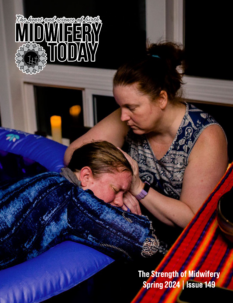
Footling Breech: A Midwife’s Own Birth Story
Editor’s note: This article first appeared in Midwifery Today, Issue 83, Autumn 2007.
Join Midwifery Today Online Membership
 The positive and powerful attitude I have toward birth, specifically breech birth, is a reflection of my own entrance into this world. I have always loved to take care of breech babies and have had the privilege of assisting in hundreds of breech homebirths. Each time, I am thankful to God and experience a calmness and assurance that comes from thinking back to my own birth memories.
The positive and powerful attitude I have toward birth, specifically breech birth, is a reflection of my own entrance into this world. I have always loved to take care of breech babies and have had the privilege of assisting in hundreds of breech homebirths. Each time, I am thankful to God and experience a calmness and assurance that comes from thinking back to my own birth memories.
All children thrive on hearing—over and over again—how they came into this world, and I was no exception. We as midwives help and support moms to have safe, good and powerful birth experiences. I know that by doing this the moms in turn will imbue their children with not only the normality and blessing of birth, but also will help them have good self esteem and strength regarding their lives in general!
In my case, I can remember from early on that I chose to come into this world upside down and that I was okay being different and doing things differently. I was forever hanging upside down from trees watching my friends play in the sandbox.
At times I wonder why I have done so many things in my life in reverse. Even in my life’s calling as a midwife, why did I work for over 20 years as a lay midwife, delivering thousands of babies at home before I went to school and got formal training? Why did I take over forty years to finally put my birth story on paper for Midwifery Today—despite the fact that I have tried so many times?
The Second World War was raging in Germany, with chaos everywhere. Many cities had been bombed and burned down and were in ruins. Times were hard for everyone. All men, many women and even older male children were forced to fight in a losing war. Only the very old, the very young and some women were left. Confusion and turmoil reigned.
My mother was pregnant with me and fled into the country to stay with some friends who were farmers with a very small plot of land and a few animals. My father was somewhere in Europe. She didn’t know where he was or if he were dead or alive. Only several years later did someone inform my mother by mail that my father had been shot by Germans and that he may have been in the resistance. No one knew about that part of his life. He was a doctor and had told my mom that he would be there to help with the delivery and if he was not there he would most likely be dead. She knew he carried cyanide capsules with him for many years.
My grandfather also was a doctor—a radiologist—and my mom didn’t trust him because he didn’t like birth. When he was preparing to graduate from medical school he failed the first time because he delivered a child during a test and then proceeded to clean up and leave, not realizing that the patient had twins! The family joke was always that his mistake was a good thing because as a radiologist he became world-famous.
No midwives lived in the little village or anywhere nearby. No cars or cabs were available and no hospitals were open in the whole area. The farmer my mom lived with had very little money or food, but the family shared what they had, even risking their own lives.
My mom was in charge of hiding several piglets in bed close to her pregnant belly; they would cuddle up to me. The animals had to be hidden and could not make any noise, because if the authorities found anyone hiding animals the whole family would be shot to death on the spot. All baby animals were counted by the state and belonged to them. The farmers had no right to keep them for themselves. So, before I was born I slept with the animals.
Later, as a young girl, I often went on vacation to horse farms and slept in the stables with the animals at night in the straw. I also was told that I used to go to the pigpen and try to eat the freshly made mashed potatoes the pigs were fed. The baby pigs my mother hid had to be killed in order for the family to survive. My mother to this day cannot eat pork sausages.
In the middle of the night sirens would go off and everyone would run into the nearby bomb shelters. There my mom met a very, very old country doctor who was skilled in both human and animal birth. I was never told whether he was a vet or a medical doctor by trade. He checked my mother and told her she was carrying me in breech position, but that she had nothing to worry about and he would help her. His only concern was her strength. He arranged for her to live in a nearby cloister (this must be the spiritual root of my practice) with Protestant nuns. They had donkeys, goats, lambs and chickens, as well as a vegetable garden. They kindly took my mom in and she regained her strength because she finally had real food to eat. The doctor came and looked after my mom and the animals, many of which were also pregnant.
Animals have played a big part in many of my homebirths. A dog or cat is like the first child to some parents and is part of the bonding experience with the new baby. I remember one birth that took place in a cabin way out in the woods by a creek (which had salmon) near the Canadian border. Two huge pit bulls came out of their beds in front of the fireplace just as the baby was being born. Each stood over one of my shoulders watching me. The intensity was a little much for me; I was nervous and hoped that they wouldn’t notice. The minute the baby cried they just sniffed the baby, relaxed and went back to their beds. I also relaxed then.
At another birth a big brown Doberman was like a doula to the single mom. He cuddled up with her during labor and, honest-to-goodness, he breathed properly during the pushing stage. Then all of a sudden he jumped up and went right next to the baby as he was being born. Again after the baby cried he was okay, and he went back to being beside his owner.
Even scarier was when a couple told me that their pet boa constrictor (a really big snake, for those who don’t know) was roaming loose in the apartment. I forgot about it during labor because he was nowhere in sight, but during the birth as the baby’s head emerged so did the snake’s, from under the bed (he had been hiding in the coils of the mattress). He scared the daylights out of me; he looked like a dragon—not at all friendly. I much prefer small cats and dogs: I am sure that every midwife has cuddled up with them from time to time during a long labor.
As the time of my birth grew closer the doctor would stop by once in a while and have a big glass of homemade beer with my mom, while assuring her of the safety of her upcoming birth. My mom thinks back fondly to these talks and she still loves beer!
I remember that in the old days, in Germany and in southern California, we used to give beer to laboring women. I remember when I first started to deliver babies in the hospital (in addition to my homebirth practice), I sent a Dad out to get a six-pack of beer for us because the mom was just in the beginning of labor but didn’t want to go home. A labor and delivery nurse overheard us and threw a fit; she told me I could lose my license as well as my staff privileges by doing this. Then she proceeded to tell me what hospital protocol was for this situation: She walked me over to the drug cabinet and gave me a prescription pad and instructed me to order morphine to calm the mom down. I couldn’t believe it: Morphine was okay but beer was bad?
In any case, my mom drank her beer and received great comfort and strength talking to the old doctor. The best part of the story is the old doctor’s instructions for when to call, i.e., how to tell when the time was right. His first instruction was to do nothing! and see if labor goes away. Then eat bread and butter (still my favorite food) and drink beer, and then do nothing! He instructed my mother that when the labor got so intense that she thought she couldn’t take it anymore, she should go for a walk in the garden or the hallways of the cloister with one of the nuns. He told her to do some slight breathing during contractions and lean on the wall, the fence or a nun. After that she should again do nothing!
He further advised that if she thought she couldn’t do anything anymore she should lie down on her left side with two pillows between her legs and do nothing! At this point he said she should tell the nuns to feed the donkey. When the donkey was full, they should hitch the wagon to the donkey and go get the doctor. He told her when he got to the cloister he would eat some food, have some beer and check in with her and that he would still have lots of time to prepare for the birth.
This story stuck in my mind and has helped me tremendously as a midwife. I still give similar instructions to my expectant moms, especially when they have breeches. I tend to put gas in my car, get some food and find some knitting before I leave and still get to the house in plenty of time.
I love the story of my Danish mom who just had to come to the US because her husband had taken a one year job at the university in Santa Cruz. He had a double PhD in astronomy, and she was also very highly educated. When she came in for her consultation appointment I asked her if she was looking into a hospital or a homebirth for this baby. She looked at me totally blankly and firmly stated she was there because she was pregnant. She insisted that she needed a midwife, not a hospital. When I explained that in the US women commonly have their babies in hospital, she couldn’t believe it. She said she was healthy and only sick women went to the hospital in her country. Her viewpoint was refreshing.
Then she told me the story of her first birth (back in Denmark). She had called the midwife, who stopped by to check on her. The midwife told her she was only 6 cm dilated and because the baby was her first, she should call back when she had the urge to push. The mom did so and the midwife came in, caught the baby and went home. The midwife left her apprentice behind, though, for a full two weeks to help. This practice is common and is funded by the government. She couldn’t believe that in the US she had to hire a postpartum doula and pay from her own pocket.
Sure enough, this woman did not call me until she had the urge to push; I barely made it. I stayed for a few hours after the birth. I couldn’t help myself, so I asked my student to stay and she agreed to stay for two weeks. This arrangement worked out very well because my student learned a lot of things she would not have learned from me.
When my mother went into labor, she said she ate plenty of bread and butter and drank dark beer. She fondly remembers that when the doctor finally arrived he checked her cervix with one hand and ate a salami sandwich with the other. (In the old days we as midwives would do similar things, like checking out the placenta with one hand and drinking orange juice with the other.)
My mom remembers finally lying down and resting, while the nuns did their chores.
Once in a while someone would ring the abbey’s doorbell outside and a stranger in worn clothes, with sunken eyes and pale face, would stand outside asking for a piece of bread. Some were soldiers, some were evacuees from the nearest bombed-out city, some were children, some were friends, and some may have been foreign enemies, but all of them were fed bread and soup. My mom would hope against all hope that one of these visitors would be my father or at least a messenger with a note from him.
I heard many stories later of women bringing food to the fences of concentration camps and prison camps and praying that somewhere in the world a woman would give some bread to their fathers, brothers, sons or husbands. That was a common bond among women; to them no one was an enemy.
One of my earliest memories was of looking at big black combat boots, and a kind American soldier during the occupation bending down, handing me a piece of chocolate and saying “hi” as he patted me on the head. My mom would always say “thank you” to our liberators. My desire to come to the US as a teenager came from this experience; I wanted to meet the people who helped us and saved us from starvation and war.
After a few more hours of labor my mother’s waters broke and she felt like pushing. She remembers that she could push until after she felt my feet and body come out. She remembers the doctor pulling her down at the edge of the bed and, with a strong voice, saying “Push like you never have pushed in your life.” Then he started counting: “One, two, three, four…think like you have to push a cow through a door to the outside.” She did and there I was.
I have been told that hearing your baby’s first cry is like the heavens opening their doors for just a few minutes and the angels singing Halleluiah. I will never get over the awesome power that comes at the moment of birth.
My mom doesn’t remember much after that except that the kind nuns cut some fresh flowers and put them quietly on her nightstand and gave her time to bond.
My mother explained to me later that I lived for nine months inside of her and that my home was called “Gebaer Mutter,” which translated means “bearing or birth mother,” and that my food came from a “Mutter Kuchen,” or mother cake (the placenta). Before I could be born the “Mutter Mund,” the mother mouth or cervix, had to open up to let me come out with my feet first. I still use the German terms to explain what is happening to mothers and their children.
Everything happened so normally, so peacefully, so powerfully—despite the horrible circumstances surrounding my birth—to give me a good start in life. I am thankful to homebirth and the kind people who cared for my mother.
I can never forget one mom I helped, who had a really bad experience with her first birth at the hospital. She was very hurt and mistreated during that experience. She was really looking forward to a homebirth, and everything that went with it, for her second child. Unfortunately, the baby died suddenly during the seventh month. The situation was very tragic and no one knew why the baby had passed. Her water had suddenly broken, she had the urge to push and there I was delivering her deceased baby. We were so sad.
A year later she carried a baby to full term, with a perfectly normal, healthy pregnancy and labor. As that baby’s head was crowning the memories came back to me and I was scared. This incredible woman encouraged me through her birth. She looked at me and said “Veronica, don’t feel bad; honest to God I have nothing but the sweetest and most beautiful memories of my last birth. I have nothing but good feelings. It was more peaceful and better than my hospital birth. Go ahead and deliver my baby.” I had to hold back my tears as I caught this baby. Soon the angels were singing at this birth.
I remember another woman who, throughout the course of her prenatal care, made me promise to catch her baby with her in hands-and-knees position. She came for one of her weekly appointments and all was well, with the baby head down. The following week she couldn’t make it and before the next appointment she went into hard, fast labor. She called me, saying that her water had broken and she felt the urge to push. I drove as fast as I could to her home (forgetting calmness and speed limits) and ran in to find her on her bed on her hands and knees with two little feet coming out. My instinct was to turn her on her back because all of my breech training was in that position. Then I remembered my promise and turned myself upside down instead and caught that baby. She didn’t realize until I told her that she had given birth to a footling breech, but in hindsight, she remembered how she had felt the baby turn. She just never thought about it. In any case, there is nothing wrong with baby and midwife both being upside down during birth.
I remember that in the hospital when a breech was expected an alarm was set for four minutes. If the alarm went off a cesarean had to be done. Having this timer on freaked everyone out, although I don’t remember it ever going off. The babies always came out, but the doctors were skilled back then and the women were unmedicated, which makes all the difference in the world.
Later in life I had the privilege of learning from Dr. Marchbanks and Dr. Ettinghausen, who did homebirths and had two or three breeches a month, some of them second twins. In all of the breeches we did together no one ever panicked and no one ever needed to be transferred; the labors were all strong and the births were fantastic. The two doctors were calm and skilled and saw breech as a variation of normal—nothing to be scared of. They were able to assure the moms that they were strong, capable women fully able to give birth to their babies safely.
The two doctors had different styles, but they didn’t turn anyone down if they were healthy. The mom had to be healthy, strong and determined to birth her baby naturally; other than that, size or position didn’t really matter. Our main concern was that right from the beginning labor should be strong, dilation should progress and the urge to push should be strong. If the labor was long and soft and not very vigorous we would take them to the hospital so we could use Pitocin to encourage vaginal birth.
Dr. Ettinghausen always delivered the breeches on a special chair/table he brought with him and set up in the kitchen. (I always found this a bit weird, but it worked for him). We helped hold the mom’s legs, while the baby hung down during delivery and gravity helped the head come out. Once in a great while he would use forceps.
Dr. Marchbanks preferred to have the birth on the bed or the bedroom floor. He always delivered the baby upwards. I would wrap the baby in warmed blankets and hold him or her up while the doctor helped the head come out. The mom pushed really hard as the head came out. This required us to put tremendous pressure on the perineum. Sometimes we even put a clean wooden spoon in the birth canal to hold the floor of the vagina down and ensure an airway for the baby. Of course, we encouraged the mom to blow through the urge to push and not actively engage in pushing until the baby was rumping. Then she gently pushed until the baby was out past the umbilicus and a loop of cord was pulled down. Then one shoulder and the other would be born, and only when the head was coming out would hard pushing be elicited. Again once in a great while a gentle assist with the forceps was used. In such cases the doctor never tugged and the baby was never damaged. I don’t remember us ever doing an episiotomy, but from time to time some women tore a bit.
Those were the good old days for homebirth breeches because the moms had a choice of qualified and experienced care providers. I hope we return to that again. One of the biggest obstacles is that most doctors today don’t know how to deliver breeches vaginally and those who do haven’t done so in many years, so they’re out of practice. Delivering a breech vaginally has become a lost art.
Just a few months ago I attended a wedding, a celebrity affair, between a supermodel and a man in the music industry. I had delivered the bride and her two sisters, one of whom was breech, at home. I felt like a fish out of water at first—just hours before arriving at the wedding, my assistant Pauline and I had been up all night at a VBAC birth. I got home just in time to shower and leave again, and then there I was shaking hands with a famous rapper.
At the reception the family spoke about what had been important in their lives. The youngest sister, the breech baby, told her sister, the bride, that one of the reasons she loved her so much was that her mother had always told her that as her little bottom was born all bruised—as they often are—her older sister exclaimed to the weird thing she saw being born “no matter how you look I will always, always love you!”
This story strengthened her love for her older sister even on the day of her wedding almost 30 years later. The bride responded with how much she loved her two younger sisters whose births she had witnessed in the family living room. Then she thanked me for being the family midwife. I was honored and touched.
I think of all of the young yet influential people in that room who may now go home and ask questions or do research about homebirth. The effect may be far-reaching if even one of them decides to have a homebirth. It will be in the magazines and in the news and will strengthen midwifery. I have such a sense of hope.
Young women who were told the truth about their births grow up knowing birth is normal and beautiful, no matter which way the baby is facing. Imagine little girls growing up with midwifery and homebirth as the norm.
















